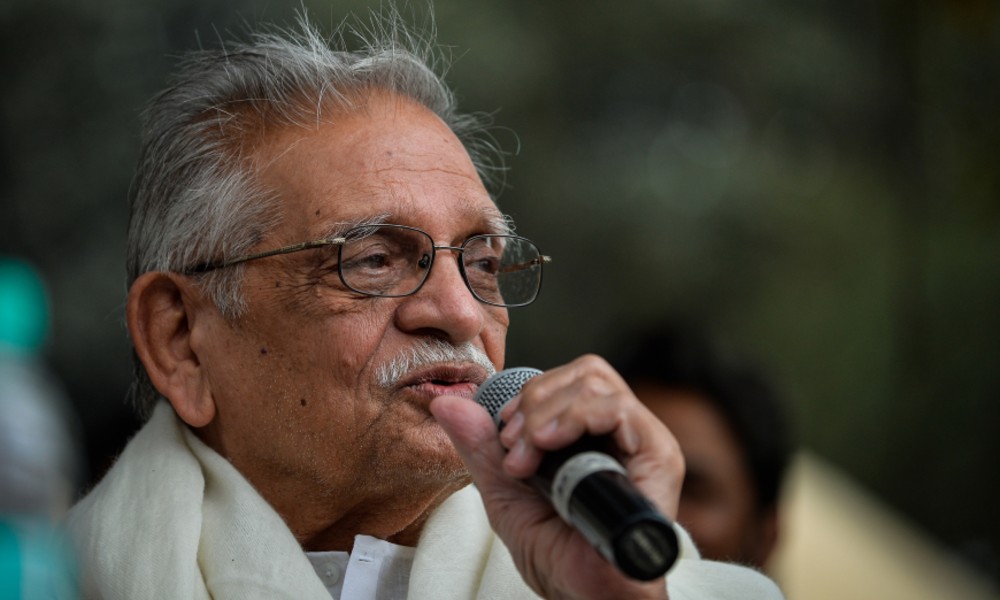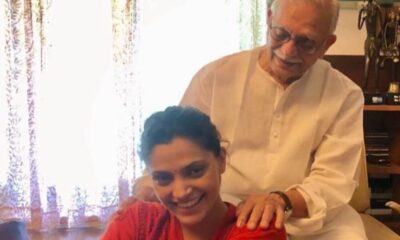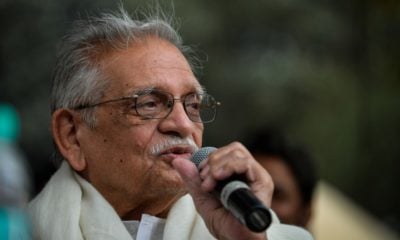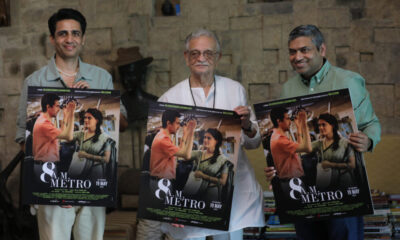Exclusives
“Unless and until one draws one’s horizons and closes it, one remains stagnant”, Gulzar tells Jyothi Venkatesh
Not many are aware of the fact that Sampuran Singh Kalra, a motor car mechanic who had migrated from Pakistan and looking for a chance to write lyrics is the Gulzar of today.
Published
3 years agoon
By
CB Desk
Today is the legendary lyricist-director Gulzar’s 87th birthday. Not many are aware of the fact that Sampuran Singh Kalra, a motor car mechanic who had migrated from Pakistan and looking for a chance to write lyrics is the Gulzar of today. We wish him a happy 87th birthday, by reproducing this rare interview of GULZAR by JYOTHI VENKATESH taken Jyothi Venkatesh at the release function of the ghazal album Nayaab Lamhe at Hotel Sofitel, when Gulzar Saab asserted that physical appearance is very necessary for an album to grow gradually because you just cannot go on downloading the songs on the digital format and sit down to listen to them.
“It should be possible for you to sit and spend an entire evening just listening to one shaayar, if possible. Though Pankaj Udhas suggested that we should title the album as Lamhe, I suggested to them that we should title it Nayaab Lamhe since Pankaj’s daughter’s name is Nayaab and he agreed immediately. His daughter Nayaab is looking after the marketing of his music label Velvet Voices. It is very sad that the non film music space has shrunk rapidly today because of the influx of digital music and also the emergence of pedestrian music which has led to very less discerning audiences. At one time, believe it or not, non film music used to occupy at least 70 percent of the space and was almost parallel to film music space.”
Also read: “Though it has been almost 66 years since I started acting, I’d still say that it is beautiful to be an actress”, says Aruna Irani
Talking about Gulzarsaab’s influence on him, Pankaj Udhas said, “Call it coincidence or just destiny, in my childhood in the 50’s and 60’s, the radio was the only source of entertainment for me. Music of course was my passion even then. It was on radio that I had heard for the first time the song Mora Gora Ang Dhai De for the film Sujata written by Gulzarsaab and I started admiring the Gulzar- Lata Mangeshkar combination as lyricist and singer though frankly I did not have the ‘samajh’ at that point of time. Gradually I started listening to more of the songs of Gulzar”.
Pankaj continues. “From the very first time I met him, Gulzarsaab made me feel very comfortable and at home during all our sessions. The album is very spontaneous asI wanted Gulzarsaab to write what he thought freely without any briefing from me. In any case, who am I to give a stalwart like him a briefing and limit him? Gulzarsaab has a tremendous knowledge of music and every song that he has written till date right from the time he had written Mora Gora Ang Dhai De is a gem. His poetry is always flowing and outstanding, especially in the album Nayaab Lamhe. I can only say that I will cherish the experience of working with Gulzarsaab all my life. It is one of my finest experiences in the 40 plus years of my singing career and I look forward to coming up with more such collaborations in the near future.”
Also read: Bhoot Police is here, Watch the tale of two crazy brothers who are here to take you on a laughter ride!
“It should be possible for you to sit and spend an entire evening just listening to one shaayar, if possible. Though Pankaj Udhas suggested that we should title the album as Lamhe, I suggested to them that we should title it Nayaab Lamhe since Pankaj’s daughter’s name is Nayaab and he agreed immediately. His daughter Nayaab is looking after the marketing of his music label Velvet Voices.It is very sad that non film music space has shrunk rapidly today because of the influx of digital music and also the emergence of pedestrian music which has led to very less discerning audiences. At one time, believe it or not, non film music used to occupy at least 70 percent of the space and was almost parallel to film music space.”
How do you constantly change yourself by re-inventing yourself?
If one is aware of oneself, the society, the changing times and one’s fellow human beings and is creative, one can just not lag behind, even if one wants to. Your expressions have got to change. You just cannot say I will sit with a hookah and bidi. Unless and until one draws one’s horizons and closes it, one remains stagnant. Yashji is one person who is aware emotionally, mentally and a maker who knows how to connect with even the younger generation. Either you deny the change or adapt to it. However I do not think I can make a film like Bunty Aur Babbli. How can language not change, if film, society and food can change? I cannot put Ghalib’s Dil-E-Naadan in today’s songs. Can I? I cannot put Lucknow’s Urdu in Paheli, which has the essence of Rajasthan.
You started your career as a director with Salil Chowdhary and not R.D. Burman as the music director!
I began my career as a lyricist with the song Ganga Aaye Kahan Se sung by Hemant Kumar and composed by Salil Chowdhary way back in 1961 for the film Kabuliwala. I remember having been paid a princely remuneration of Rs 300 for writing the song Mora Gora Ang Laile in Bandini composed by S.D. Burman and sung by Lata Mangeshkar in 1963. Though in 1971, I wanted R.D. Burman to compose the music for my debut film as a director-Mere Apne, my producer insisted on going in for Salilda and I had no choice. It was only in 1972 that R.D. Burman composed my songs like Musafir Hoon Yaaro (sung by Kishore Kumar), Mitwa Bole Meethe Bol (Bhupendra), Beeti Na Bitai Raina (sung by Bhupendra and Lata Mangeshkar) and Saare Ke Saare Gaama Ko Lekar (sung by Kishore Kumar and Asha Bhosle) all for the film Parichay.
You may like


Actress Saiyami Kher Reflects on Her Special Bond with Gulzaar Saab on World Poetry Day


Gulzar: “Though people used to say that Nana Patekar is a temperamental actor, he was obedient when I directed him on the sets of Hu Tu Tu”


Saiyami Kher reunites with Gulzar after Mirzya; to recite his poetry in her next


Gulzar releases the poster of Gulshan Devaiah and Saiyami Kher-starrer ‘8 A. M. Metro’


What was Tabu’s startling revelation at Kuttey album release?


Gulzar and Vishal Bhardwaj’s Mehfil-e-Khaas, the music launch of Kuttey








